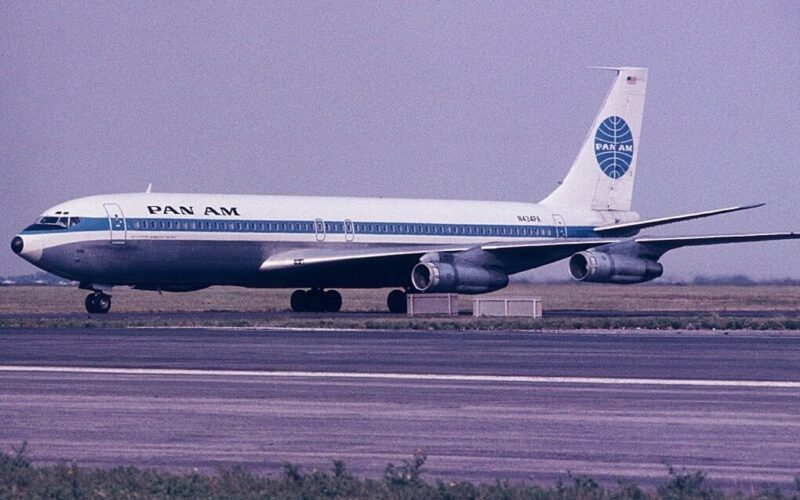On October 26, 1958, Pan Am Boeing 707 took off from Idlewild Airport (now JFK International Airport) to Paris, France. The airline’s first daily transatlantic flight named Clipper America started a new era of commercial aviation.
Creation of Boeing 707
In the beginning of 1950s Boeing was well behind airplane makers in the United Kingdom and the Soviet Union, who were already operating passenger jets. England’s de Havilland DH 106 Comet first flew in 1952 but was soon overrun with structural problems that caused three of them to crash over a period of two years. Soviet Union’s Tupolev Tu-104 Camel became the world’s only commercial jetliner between 1956 and 1958, when the Comet was grounded, but it had capacity for only 50 passengers.
Boeing’s designers made innovative decisions when constructing the 707. They swept the aircraft wings further back than the de Havilland team swept the Comet’s. Boeing also had an unusual concept of installing the engine pods beneath the wing. By doing this, the 707 pylons guided the airflow over the wing on a straight path.
The 707 first engine, the Pratt & Whitney JT3C, won the 1952 Collier Trophy. It was quieter, more powerful, and more fuel-efficient. The remarkable two-spool engine produced 11,000 pounds of thrust, compared with the Comet’s Avon, which produced 10,250 pounds.
Pan Am 707 starts flying
America’s first international airline Pan American World Airways (Pan Am) acquired its first Boeing 707-120 on August 15, 1958, and immediately started planning the daily transatlantic jet service from New York to Paris. The world was anticipating the moment when a new era of traveling would begin. Boeing helped to build the anticipation with ad campaigns underlining the safety and comfort of jet travel. One ad announced: “Only seven hours to brush up your French”.
On the night of October 26, 111 passengers and 12 crew members boarded the Boeing 707 on a red carpet while a US army band was playing for them. Actress Greer Garson, also a passenger on the flight, performed the ribbon cutting, and at 7:20pm, the sleek 707 started its journey.
The Pan Am flight was comfortable and smooth. Passengers chatted and enjoyed onboard luxuries ‒ drinks and hot-meals served on china and set on linen-covered tables. Due to headwinds the aircraft had an unscheduled stop in Gander, Newfoundland. At 10:01 am, 8 hours and 41 minutes after leaving New York the flight landed at Paris Le Bourget Airport.
Jet Age ensues
On the tail of the aircraft, Pan Am painted a huge blue globe. With the airlines’ new and faster routes around the globe this new logo was a symbol that promised travelers the world.
By December, 1958, the 707 was flying the route from New York to Miami and in January 1959 the company started the first transcontinental flight from New York to Los Angeles. The Boeing 707 is often credited to have started the Jet Age. It was the dominant long-distance jetliner until the wide-body Boeing 747 was launched in 1969.
Pan Am’s Boeing 707 affected world affairs like no other aircraft would. It influenced economies, politics and culture, fashion and society. Pan Am also opened the doors to a generation of educated women who could work as flight attendants and earn respectable wages. These opportunities would help them move towards greater social and financial freedom.
With shorter flying time, the world was full of possibilities. Commercial jet travel would become customary and grow immensely in the next few decades. According to the International Air Transport Association, it grew from 87.2 million passengers in 1957 to 4.34 billion in 2018.

